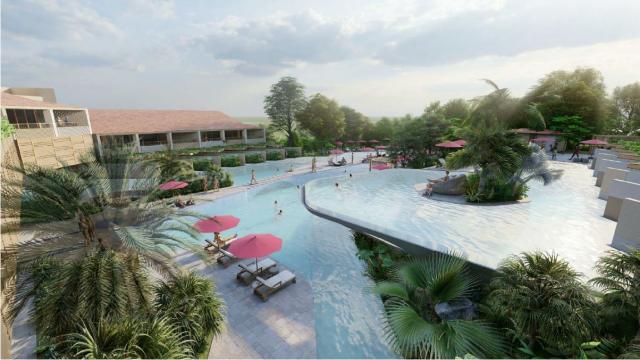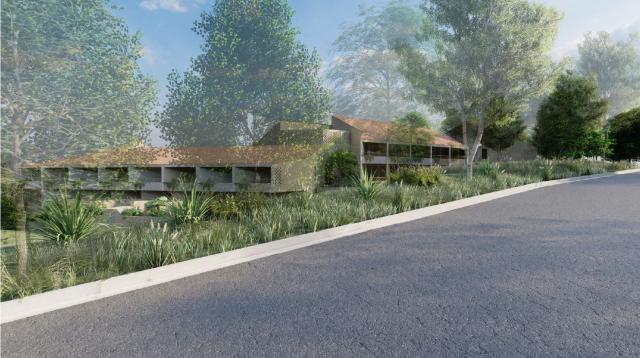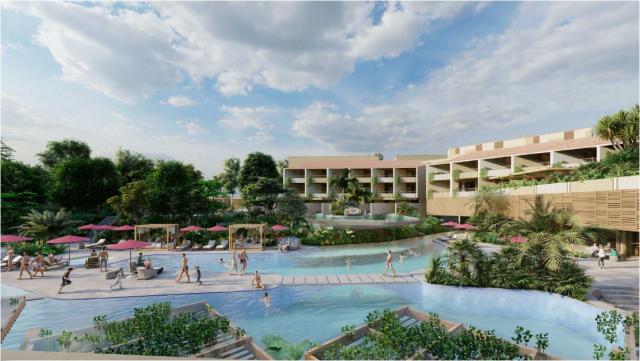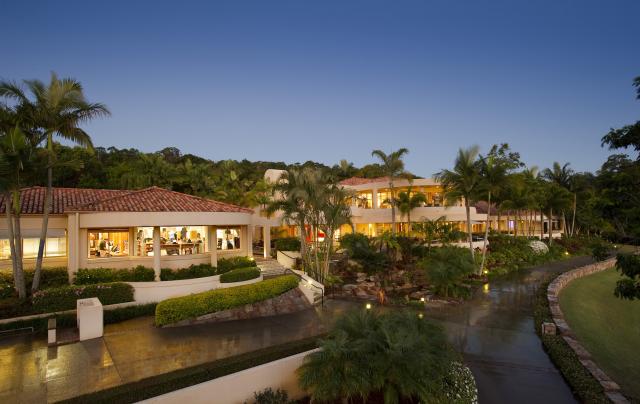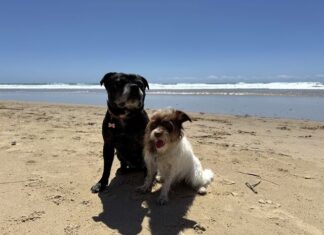Three deputations were delivered to the final Council meeting in 2024 to voice opposition to a proposed development by GH Australia, the Australian arm of Hong Kong property and development firm, Golden Horse Group and owner of Noosa Springs Golf and Spa Resort, of a 106-room, five-star hotel next to the resort.
The application has been before council several times, during which council staff have recommended approval of the development and councillors have voted against it, with the applicant each time halting the approval process before a final decision on the application was made.
Inconsistencies with the Noosa Plan 2020 that included being outside the urban growth boundary and inconsistent use of land zoned Recreation and Open Space, the clearing of vegetation in an area mapped biodiversity overlay and a known koala and glossy black cockatoo habitat, noise concerns and odour concerns, confliction with the State Planning Policy by being in proximity (220m) to a sewerage treatment plant (STP), were among the reasons given for the refusal.
Councillors also took into account a large number of “valid planning grounds“ raised by submitters indicating “an unacceptable level of impact on the amenity of the locality“ as well as a valid submission from Unitywater identifing potential risks and flow on costs associated with the proposed development in proximity to the STP.
Deputations have been delivered previously to council both in favour of the application and against.
GH Australia director Ellen Guan has previously said the reasons listed in council meetings for refusing the development application had all been addressed in the application and, after an exhaustive assessment process, supported by Noosa Council officers and experts engaged by the council to provide independent advice.
“Since 2018 we have worked collaboratively with council officers at great expense to prepare the hotel development proposal that clearly deals with all relevant planning issues,” Ms Guan said.
“During the engagement phase we made numerous changes to the proposal in response to public submissions received, and the further issues raised by council officers and its expert consultants.
“The council’s own planning officers thoroughly reviewed and interrogated the development application over an extended assessment period and have recommended its approval subject to conditions,” she said.
With the likelihood the application would again be brought to a council meeting and recent changes made by council to its Standing Orders and Deputation Procedures, Unitywater’s Rhett Duncan, Noosa Springs residents John Cochrane and Kim Petrovic and Noosa Springs Tennis Club representative Kristy King voiced their concerns about the application at council’s ordinary meeting on 17 December.
The hotel application was not before council in the December meetings.
Under council’s new Standing Orders “deputations on specific development applications or other statutory applications before Council are not permitted”, with the result that no deputations will occur at a meeting where the application is listed for discussion and decision.
Unitywater representative Rhett Duncan told the meeting it was Unitywater’s third deputation and they remained firm in their opposition to the proposed development under the current application.
“Noosa sewerage treatment plant has been in operation in its current location since the 1970s,” Mr Duncan told the meeting.
“The entire network consists of 418 km of sewerage mains, 10,300 maintenance holes and 114 pump stations all configured to transport sewerage to this specific location, which has been operating successfully for over 50 years.
The plant can’t be picked up and relocated without enormous cost, and years of disruption to all sewerage service to Noosa residents and community and hundreds of thousands of annual visitors.
When the plant needed upgrading in 1995 Council made the conscious decision to shift the plant closer to the southern and western property boundaries maximising the distance to existing residencies to the north. This is consistent with recommendations in the environmental impact assessment commission by Noosa Council to keep sensitive receptors (meaning people) more than 400m away from the treatment plant.
“There doesn’t seem to be any reason to change this and increase the risk of odour impact by introducing more sensitive receptors within the 400m distance.
However the current development application locates the swimming pool and outdoor amenities approximately 150m from the sewerage treatment plant (STP) site boundary and approximately 200m from existing odour generating processes.
Plant operations haven’t changed. In fact there’s greater treatment occurring today as the Noosa community population grows and visitor numbers continue to increase year on year. The Noosa STP operates within its licensed capacity however is subject to significant peak loading during holiday periods, meaning the highest risk of odour is during peak holiday occupancy at the proposed development.
Approval of this development also put council in direct conflict with state planning policy, July 2017, which seeks to protect STPs from encroachment.
“What is this 2.5 odour contour line, what does it mean?
There’s been a lot of discussion on this 2.5 odour contour line.
“Firstly the applicant would like you to think it is a hard and fast line beyond which there are no other issues. It’s not the case.
“The odour modelling exercise is a scientific means of assessing the risk. It’s not the law and it does not release Unitywater from its obligations under the law.
“The Environmental Protection Act of 2024 legislative changes specifically focus on odour meaning odour is now treated as an environmental nuisance that may constitute serious environmental harm. This is the law and carries both financial penalties and possible imprisonment.
“A crucial point is the 2.5 odour contour line modelling is a modelling estimate, based on a point in time when data was captured nine years ago. It’s not a single hard line where people experience odour on one side of the line and no odour on the other side.
“The modelling outcome will shift with prevailing weather conditions like wind direction, velocity. It is sensitive to the density of surrounding vegetation and impacted by operational conditions of the plant which change throughout any given day.
The 2.5 odour contour line is an average of all the modelling predictions based on the data used. In some scenarios the 2.5 odour contour line will be closer to the treatment plant and others it will be closer and potentially beyond the proposed development.
Recent information received from the previous plant operator confirms that since the upgrade was completed in 1997 there have been 12 odour complaints recorded, all of which stem from beyond the 2.5 odour contour line.
“In fact six of those are from the 1.25 odour contour line, based on 2016 modelling. Another consideration is if vegetation densities change, such as clearing prior to construction, this may render the modelling invalid. Our climate is also changing bringing into validity the nine year old data collected in 2016.
“Our modelling only considers the quantifiable experience, being something people might smell. It does not distinguish type of odour, or take into account how different people might react and respond to a smell. The odour contour line modelling does not take into account or consider what is unquantifiable, by this I mean variations in daily plant operations, changes in daily weather or individual sensitivity to smell or lived experience of living close to a sewerage treatment plant.
“The modelling is based on predictibility of 99.5 percentile of odour. We do not know the 100 percentile. By using the 99.5th percentile the modelling is saying odour will be experienced for 44 hours per year.
That may not sound like a lot however imagine a fully booked hotel, guests sitting by the pool smelling a plant for eight hours while they’re trying to enjoy their holiday.
“By modelling the 99.5th percentile for the development, you should also be presented with the case at the 100th percentile which is the actual worst case scenario, as this may present a very different picture. This is the unquantifiable, which is the lived experience.
“Changes to environment protection act now mean odour is treated more significantly. Contravention of the Act may constitute serious environmental harm.
A new offence has been created under the Act where contravention causes or is likely to cause serious harm. Penalties are fines and even up to two years jail time.
“If this development is approved council is putting sensitive receptors right back in the frame on the doorstep of the contour line. Council is placing a reverse amenity risk back on Unitywater and therefore back on to our customers. Unitywater could also be faced with a civil suit from Noosa Springs if odour causes an impact on their hotel business.
“It only takes one individual to complain about their lived experience of staying at the hotel during an odorous event and the regulator will have cause to investigate. At that point it won’t matter what any modelling says because the lived experience of that complainant is what matters.
“Unitywater knows this firsthand.
“From experience, at one of our sewerage pump sites one complainant, using an adjacent property in 2020, resulted in a $1m upgrade and subsequent legal matter that remains ongoing. The pump station had operated without complaint in middle suburbia for over four years. The operating and financial implications of one person’s lived experience can have far reaching impacts on our business.
“We all know the power of social media where a single complaint can quickly escalate into a do not stay at a stinky hotel message.
“I cannot put more firmly on the record that the combination of enforced reverse amenity, an unknown lived experience can result in action against Unitywater that may lead to prosecution, costly plant modifications and financial loss resulting from defending or attending to settle a civil case.
“This council is a shareholder in Unitywater so will be directly impacted by this outcome.
“We don’t have a blank cheque for upgrades or for defending in legal actions that are preventable.
Last time I mentioned a forced upgrade at Murumba Downs and that cost $30m in 2010.
“Unitywater is an essential service provider.
“We operate responsibly, lawfully for the benefit of Noosa residents and the community. We support development that promotes sustainable and responsible economic growth but we oppose the location of this development because it locates sensitive receptors closer to existing sewerage treatment operations.
“It only takes one complainant with a negative lived experience at a new hotel to expose Unitywater to potential enormous reputational and financial risk and serious ramifications.
“These can be prevented by council backing its 1995 decision to establish a 400m buffer zone and comply with state planning policy regarding encroachment by development.
“Unitywater are asking Noosa Council to not approve this development in this location.
“If the scenario was reversed would Noosa Council support a sewerage plant with a 99.5th percentile odour contour line right on the doorstep of existing luxury accommodation where the outdoor facilities of that accommodation fell well within that contour line.”
Noosa Springs resident Kim Petrovic said she was representing numerous residents who have submitted concerns to Noosa Council about the proposed development, when she delivered her deputation, listing seven concerns:
1. Out of date consultant reports – many reports, for example, odour, parking, traffic, noise, fire evacuation are outdated with some dating back to 2016 and 2017. These reports failed to account for significant developments such as the construction of Parkridge estate and Elysium which together represent over 50 per cent of the properties effected by the proposed hotel.
2. Bushfire risk – Links Drive is situated within a high potential bushfire intensity zone presenting serious evacuation challenges due to its single access road. The QFES do not recognise Eenie Creek Road as a safe evacuation option. Their concerns contrast with statements made by planning staff who suggested hotel buildings could shelter evacuees.
3. The applicants survey relied on a small non-representative survey including non-residents and visitors without targeting those affected by the development. We call for a professionally conducted, independent survey to accurately capture residents views.
4. Planning and engagement issues – we reject planning dismissal of over 400 resident objections as mere standardised responses. The notification period set during the Christmas season limited meaningful community engagement. Deadline extensions were denied and inadequate signage obscured the process further. Our concerns remain unaddressed despite multiple submissions and petitions demonstrating fault and genuine opposition.
5. Community discussion forums – the forums held by the applicant reveal inconsistencies and a lack of assurances. Claims linking the golf club’s viability with the hotel’s success lack substantiated commitments. Additionally aspirational statements about a 5-star hotel failed to address the broader communities concerns. The absence of measurable outcomes continues to undermine trust.
6 Mental health impacts – the proposed development risks disrupting the community’s sense of security and peace leading to increased stress and mental health concerns among residents. The displacement of key facilities such as pilates, physio, school holiday camps and junior tennis programs further compounds this stress.
7 Developers history and transparency – the applicants history of delays and changes in projects such as those at Milton and Hope Island raises concerns about their viability and intentions. Approving this application without clear guarantees risks exacerbating unresolved issues, potentially allowing for expansion of what is currently proposed.
“In summary this does not adequately address critical zoning, safety, community concerns that have been raised over the past three years. The outdated reports, flawed survey, methodology and lack of transparency undermine its credibility. We urge councillors to prioritise the wellbeing and the voices of the residents bearing the direct consequences of this development.”
In his deputation Noosa Springs John Cochrane told council the applicant had chosen this development over one that would comply with Noosa Plan 2020.
“We are here today because the applicant has delayed the final decision on the application councillors have voted to refuse,” he said.
“The applicant’s amended submissions are set to sway council that there are sufficient grounds to reverse the prior decision. We believe the amended application brings no new information, simply reiterates prior statements by the applicant. We note the submission contains minimal changes on design, no mitigation of impacts outlining council’s motion to refuse. This application is full of inconsistency and potential unforeseen consequences.
“No rigorous planning system could justify acceptance of such a gross non-compliance of planning controls of zoning without reference to all objectives of the zone. These are not the case.
“What the developer is potentially asking council to do is to approve a building outside the allowable zone in order to make available land in the proper zone, quite possibly for future approval.
“Let’s be clear what the applicant is asking of council. They have one parcel of land zoned tourist accommodation and another zoned open space/recreation.
“That they want to build a hotel on the open space zoned land, the only reason I can give for doing so is that it will be bigger and better than it might be if sited on the tourist zone. So council will you put aside your properly made plan, your environmental overlay, your warning from Unitywater, multiple environmental and social impacts and concerns of any residents so we can build a bigger, more profitable hotel than we might otherwise be able to build.
“This application has no new information, a real danger of future unforeseen development and no real reason to ask councillors to alter their previous decision.”
Noosa resident Kristy King told council she was communicating concerns around the hotel development on behave of the tennis community, Outside the Box Gym, Bern Pilates and Physio.
“Noosa Springs Tennis club has developed significantly over the last 20 years. It’s a very much appreciated facility that is enjoyed by Noosa Springs members, junior tennis groups, mothers groups, fathers groups, interstate tennis enthusiasts. There are 210 junior tennis players and 140 adult players who participate in wonderful programs every week.
“A few months ago two U11 female tennis players were selected to represent Queensland in a major event against NSW, only 16 out of the state were selected. We have many aspiring young athletes, tennis players starting to make a name for themselves made possible due to professional programs offered at Noosa Springs and the dedicated caring coaches who facilitate exceptional training methods.
“Should the tennis courts become unavailable, it would not only impact everyone’s sessions but would not be possible for our tennis players to go to other clubs. Other tennis clubs could not absorb the immense quantity and quality of training sessions that are being provided. Some of our junior players train twice a day.
“Junior players would fall out of the sport. They would have their sporting pathways taken from them, coaches would lose their jobs.
“Harry who operates Outside the Box Gym provides an important business to the Noosa community. He works with children, youth, adults, seniors and aspiring athletes to improve strength, fitness, confidence and overall wellbeing. He offers a Kid fit academy during holiday period from 9am-3pm. During these days Harry has an average of 40-50 children per day. This week parents told me it allowed them to continue working through holiday period.
“Bern Pilates and Physio is a wonderful business that supports our community. The Bern Pilates and Physio studio has approximately 160 people attend each week, many from Noosa Springs which has an ageing population. Many of these users will be affected by this development. They attend as a pathway to healthy ageing.
“The proposed development will remove all of these recreational activities and significantly impact our community in a detrimental way. It will also mean the dreams of our aspiring juniors, some have dreams of competing in the Olympics in Brisbane. This will all be destroyed. If our tennis community is pulled apart it will never be the same again.”
Following the deputations Ms Petrovic questioned council on the extensions on the decision-making process it had provided to the development applicant.
In response council’s regulation and development director Richard MacGillivray said extending the decision-making period was an operational decision made during the assessment process, similar to issuing an information request, extending an information response period, or sending a Further Advice letter.
“Agreeing to extend the decision-making period is part of the assessment process and not a decision on the application itself,” he said.
“Additionally, extensions to the decision-making period are often only requested and agreed to where the applicant has advised they intend to take steps to address or respond to issues raised during the assessment process.”

